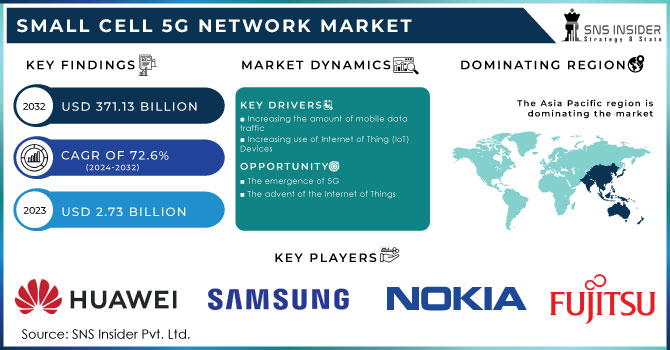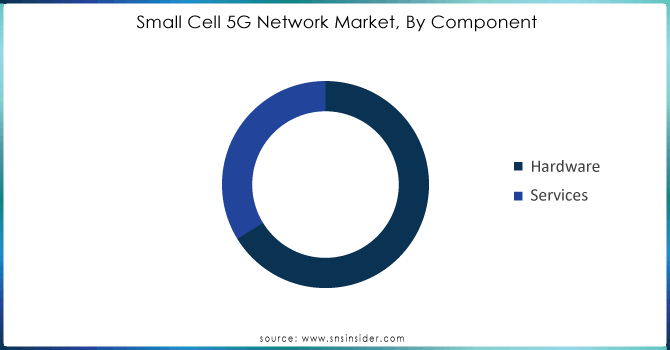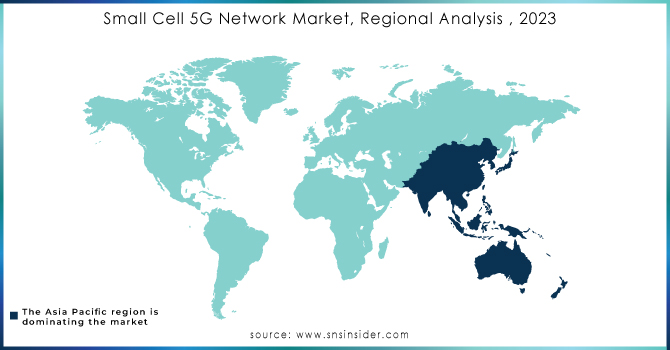Small Cell 5G Network Market Report Scope & Overview:
The Small Cell 5G Network Market was valued at USD 3.02 billion in 2023 and is expected to reach USD 176.78 billion by 2032, growing at a CAGR of 57.22% from 2024-2032. This report encompasses insights into emerging technologies adoption rates and investment trends, as well as funding opportunities fueling the growth in the market. It also encompasses cost structure analysis, which can be considered a detailed breakdown of expenditures up and down the value chain. Further, the report outlines bandwidth and capacity usage, focusing on the specifics about how increased demand for high-speed data drives the necessity for advanced small cell network solutions.

Get more information on Small Cell 5G Network Market - Request Sample Report
Market Dynamics
Drivers
-
Increased demand for high-speed data drives the need for small cell 5G networks to enhance connectivity and performance.
Data-intensive applications for instance, high-definition video streaming, online gaming, as well as cloud computing, continue to surge. Consequently, network connections need to increase in terms of speed and reliability. As such, these applications require high bandwidth and low latency. Dense areas are characterized by the inability of traditional macro cell networks to provide such requirements. Small cells ensure the challenges are addressed as 5G network performance will improve, hence speeding up data transfer. The improvement of its network capacity and coverage allows the small cell to provide the much-needed infrastructure in the present trend of growing data demand, ensuring seamless connectivity to support the advance technological wave that has emerged in the IoT and smart city wave.
Restraints
-
High initial deployment costs hinder the rapid expansion of small cell 5G networks due to significant infrastructure investments.
The deployment of small cell networks involves substantial upfront costs, including the purchase of hardware, installation, and preparation of physical sites. These expenses can be particularly challenging for network operators, especially when scaling across large geographic areas. Unlike traditional macro cells, which require fewer installation sites, small cells need to be densely deployed to ensure robust coverage, leading to higher operational and capital expenditures. Additionally, the cost of securing appropriate locations in urban or congested areas adds another layer of financial strain. This high initial investment may slow down the pace of small cell rollouts, potentially hindering the rapid adoption and expansion of 5G networks across various regions.
Opportunities
-
Small cell 5G networks enable the widespread deployment of IoT devices and support the development of smart city infrastructure.
The rapid growth in IoT devices with the demand in smart city infrastructures further creates an additional demand for fast and reliable connectivities in all densely populated environments. Small cells are very adequate for such environments as they augment coverage and offer more capacity and areas where traditionally macro cells fall short. In return, small cells deployment would enable network operators to offer dense connectivity that is required for IoT networks starting with traffic management systems and environmental sensors down to complete seamless communication across smart cities. The connection, in turn, enhances efficiency and functionality in other smart city projects, for example, smart lighting, waste management, and public safety. This would mean a significant opportunity for small cells to meet the ever-increasing data demands of these technologies in the 5G network market.
Challenges
-
Securing suitable locations and navigating strict zoning regulations in urban areas slow down small cell 5G network deployments.
The main challenge to securing appropriate locations for small cell deployments is that space is usually limited in urban areas, and zoning regulations are strict. In most cases, these regulations demand detailed approvals and compliance with local laws, which may delay the installation process. Moreover, identifying locations that offer optimal coverage without interfering with existing infrastructure complicates site selection. Often, deployment timelines are delayed because operators must negotiate with property owners or local authorities. The process is long and expensive and may not support rapid scaling of 5G networks in the densest population areas to keep pace with ever-growing connectivity needs.
Segment Analysis
By Component
The Hardware segment dominated the Small Cell 5G Network Market in 2023, capturing about 75% of the revenue share due to the high demand for advanced small cell infrastructure, including radios, antennas, and other essential equipment. The Services segment is expected to grow at the fastest CAGR of 59.87% from 2024-2032, driven by the increasing need for installation, maintenance, and network optimization services to support small cell deployments and ensure optimal 5G performance.
By Network Model
The Non-Standalone segment dominated the Small Cell 5G Network Market in 2023, accounting for about 78% of the revenue share, as it leverages existing 4G infrastructure, making it more cost-effective and quicker to deploy. The Standalone segment is expected to grow at the fastest CAGR of 59.58% from 2024-2032, driven by the increasing adoption of fully independent 5G networks that offer improved performance, low latency, and scalability without reliance on 4G networks.

Need any customization reseaech on Small Cell 5G Network Market - Enquiry Now
By Application
The Indoor segment dominated the Small Cell 5G Network Market in 2023, with about 78% of the revenue share, due to the high demand for enhanced indoor coverage in areas like offices, malls, and stadiums. The Outdoor segment is expected to grow at the fastest CAGR of 60.83% from 2024-2032, driven by the increasing need for outdoor 5G coverage in urban spaces and high-traffic areas to support dense networks and high user volumes.
By End Use
The Commercial segment dominated the Small Cell 5G Network Market in 2023, with about 31.23% of the revenue share, due to the increasing demand for reliable and high-speed connectivity in business environments like offices, retail spaces, and commercial buildings. The Smart City segment is expected to grow at the fastest CAGR of 63.61% from 2024-2032, driven by the rising adoption of 5G to support smart infrastructure, IoT applications, and enhanced urban connectivity.
By Frequency Type
The Mid-band segment dominated the Small Cell 5G Network Market in 2023, capturing about 46% of the revenue share, due to its balanced performance in terms of coverage, speed, and capacity, making it ideal for urban and suburban deployments. The Millimeter Wave segment is expected to grow at the fastest CAGR of 60.20% from 2024-2032, driven by its ability to provide extremely high-speed data transfer and support dense network environments with low latency.
Regional Analysis
Asia Pacific held the highest market share in terms of revenue during 2023, at about 43%. It is a leader, spurred by fast urbanization, ever-growing mobile data traffic, and the adoption of early 5G deployment across China, South Korea, and Japan. High-speed, reliable connectivity demands have spurred small-cell deployments within this region to become smarter, more sustainable, and economically feasible, making it its strong position.
North America is poised to grow at the fastest CAGR of 60.57% from 2024 to 2032. The strong investment in 5G infrastructure is a primary reason, mainly in the U.S. This is due to the government's nationwide 5G deployment push and the support it provides for small cell technology. Also, the increasing demand for seamless connectivity in urban and suburban areas places North America at the top as a rapidly growing hub for small cell deployments.

Key Players
-
Huawei Technologies Co., Ltd. (5G Small Cell, CloudRAN)
-
Samsung Electronics Co., Ltd. (5G Small Cell, Network Solutions)
-
Nokia Corporation (AirScale, 5G RAN Solutions)
-
Ericsson (5G Radio, Ericsson Radio System)
-
ZTE Corporation (5G Small Cell, ZTE 5G CPE)
-
Fujitsu Limited (5G Radio, Virtualized RAN)
-
CommScope Inc. (5G Small Cell, Small Cell Solutions)
-
Comba Telecom Systems Holdings Ltd. (5G Small Cell, Distributed Antenna Systems)
-
Altiostar (Open RAN, Virtualized Radio Access Network)
-
Airspan Networks (5G Small Cell, OpenRAN Solutions)
-
Ceragon (5G Small Cell, Wireless Backhaul Solutions)
-
Contela (5G Small Cell, Cloud RAN)
-
Corning (Small Cell Solutions, Optical Network Products)
-
Baicells Technologies (5G Small Cell, CPE Products)
-
Sterlite Technologies Limited (Fiber Optic Solutions, 5G Small Cell Products)
-
Cisco Systems, Inc. (Small Cell Gateway, 5G Mobile Core Solutions)
-
NEC Corporation (Small Cell, Cloud RAN Solutions)
-
Radisys Corporation (5G Small Cell, OpenRAN Solutions)
-
CommAgility (Small Cell Solutions, 5G RAN Software)
-
Qualcomm (5G Modem, Small Cell Chipsets)
-
Octasic (5G ASIC Solutions, Small Cell Processors)
-
PC-TEL (Antenna Solutions, Small Cell Solutions)
-
Microsemi (5G RF Front-End, Timing Solutions)
Recent Developments:
-
In September 2024, Ericsson unveiled its strategy for enterprise-driven 5G network adoption, introducing a portfolio that includes the Radio Dot System and small cell radios for both indoor and outdoor deployments, supporting 5G expansion across enterprise environments.
-
In February 2024, Ericsson's Mobility Report Business Review highlighted 5G business opportunities for Communication Service Providers (CSPs), focusing on the growing success of Fixed Wireless Access (FWA) and its role in expanding 5G connectivity for broadband services
-
In May 2023, Nokia and Chunghwa Telecom validated 25G PON technology for 5G fronthaul, demonstrating its capability to support the high capacity and low latency demands required for Small Cell 5G Networks
| Report Attributes | Details |
|---|---|
| Market Size in 2023 | USD 3.02 Billion |
| Market Size by 2032 | USD 176.78 Billion |
| CAGR | CAGR of 57.22% From 2024 to 2032 |
| Base Year | 2023 |
| Forecast Period | 2024-2032 |
| Historical Data | 2020-2022 |
| Report Scope & Coverage | Market Size, Segments Analysis, Competitive Landscape, Regional Analysis, DROC & SWOT Analysis, Forecast Outlook |
| Key Segments | • By Component (Hardware, Services) • By Network Model (Standalone, Non-standalone) • By Application (Indoor, Outdoor) • By Frequency Type (Low band, Mid band, Millimeter Wave) • By End Use (Residential, Commercial, Industrial, Smart City, Transportation & Logistics, Government & Defense, Others) |
| Regional Analysis/Coverage | North America (US, Canada, Mexico), Europe (Eastern Europe [Poland, Romania, Hungary, Turkey, Rest of Eastern Europe] Western Europe] Germany, France, UK, Italy, Spain, Netherlands, Switzerland, Austria, Rest of Western Europe]), Asia Pacific (China, India, Japan, South Korea, Vietnam, Singapore, Australia, Rest of Asia Pacific), Middle East & Africa (Middle East [UAE, Egypt, Saudi Arabia, Qatar, Rest of Middle East], Africa [Nigeria, South Africa, Rest of Africa], Latin America (Brazil, Argentina, Colombia, Rest of Latin America) |
| Company Profiles | Huawei Technologies Co., Ltd., Samsung Electronics Co., Ltd., Nokia Corporation, Telefonaktiebolaget LM Ericsson, ZTE Corporation, Fujitsu Limited, CommScope Inc., Comba Telecom Systems Holdings Ltd., Altiostar, Airspan Networks, Ceragon, Contela, Corning, Baicells Technologies, Sterlite Technologies Limited, Cisco Systems, Inc., NEC Corporation, Radisys Corporation, CommAgility, Qualcomm, Octasic, PC-TEL, Microsemi. |

